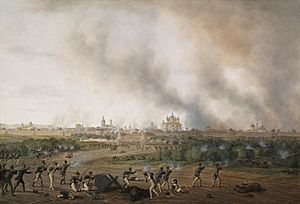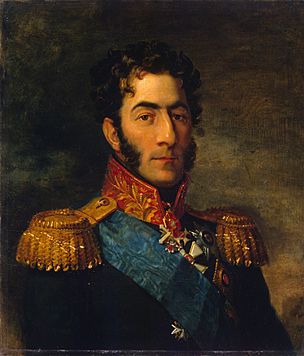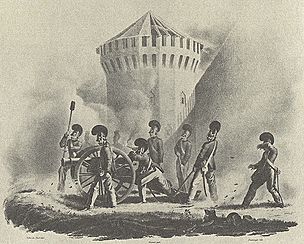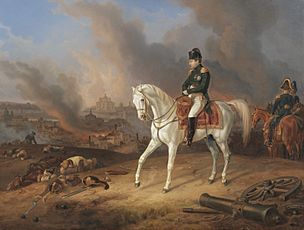Battle of Smolensk (1812) facts for kids
Quick facts for kids Battle of Smolensk (1812) |
|||||||
|---|---|---|---|---|---|---|---|
| Part of the French invasion of Russia | |||||||
 Battle of Smolensk on 18 August 1812, by Albrecht Adam |
|||||||
|
|||||||
| Belligerents | |||||||
| Commanders and leaders | |||||||
| Strength | |||||||
| 45,000 of 180,000 | 30,000 of 120,000 | ||||||
| Casualties and losses | |||||||
| 9,000-10,000 killed, wounded or captured | 6,000-14,000 killed, wounded or captured | ||||||
The Battle of Smolensk was a very important battle during the French invasion of Russia in 1812. It happened from August 16 to 18, 1812. About 45,000 French soldiers, led by Emperor Napoleon I, fought against about 30,000 Russian troops. The Russian forces were commanded by General Michael Andreas Barclay de Tolly.
Napoleon's army managed to take control of Smolensk. They forced Prince Pyotr Bagration's Russian army out of the city. The French used a lot of artillery, which caused a huge fire. Most of the city's buildings were destroyed. Out of 15,000 people living there, only about 1,000 remained after the battle. This battle was one of the bloodiest of the invasion, with over 15,000 soldiers injured or killed.
Contents
Before the Battle: The Road to Smolensk
Napoleon's Frustration at Vitebsk
After a battle near Vitebsk, the Russian army, led by General Michael Andreas Barclay de Tolly, managed to escape Napoleon's forces. This happened on July 27. Napoleon was very annoyed because he couldn't trap the Russian army in a big fight. He stayed in Vitebsk until August 12, waiting for his army, called the Grande Armée, to regroup.
Challenges for the French Army
Napoleon's huge army, which started with 375,000 soldiers, had shrunk to about 185,000. Many soldiers were sent away for other missions. The Russians also caused some losses in battles. However, the main reasons for the army shrinking were disease, hunger, and soldiers leaving.
- Soldiers had to march very quickly.
- Supply wagons couldn't keep up, so there wasn't enough food.
- Many soldiers got sick, especially with dysentery.
- The hot July weather meant there wasn't enough water.
- Many horses, which were vital for transport and cavalry, died because there wasn't enough food for them.
The Russian Generals' Disagreement
As the French army advanced, the Russians faced a big problem. Some Russian generals, like Prince Pyotr Bagration, wanted to attack Napoleon immediately. They were supported by Czar Alexander I and most of the Russian officers.
However, General Barclay de Tolly and other generals, many of whom were of German background, wanted to keep retreating. They believed this would weaken Napoleon's army over time. Under pressure, Barclay agreed to an attack on August 6. But he didn't know where the French army was.
The Russian attack plan didn't work out. There were disagreements among the generals. Barclay de Tolly was slow to act. This wasted valuable time for the Russians.
Napoleon's Clever Plan
Napoleon expected the Russians to attack. He saw this as a chance to surround and destroy their army. He created a plan called the "Smolensk maneuver." This plan was very smart.
- Napoleon wanted to go around the Russian army from the south.
- He aimed to cut off the Russians from the road to Moscow.
- His goal was to trap and destroy the Russian army, ending the war quickly.
On the night of August 13–14, French engineers quickly built four pontoon bridges across the Dnieper River. By morning, about 175,000 French soldiers were marching quickly towards Smolensk.
The Fight at Krasnoy
Before reaching Smolensk, a smaller battle happened at Krasnoy on August 14. General Neverovski's Russian division, with about 5,500 to 7,200 soldiers, was guarding the area. They were attacked by 20,000 French soldiers.
The French failed to work together well. This allowed the Russians to escape, though they lost about 1,500 to 2,300 men. The French had several chances to completely defeat the Russians but didn't. Neverovski's troops retreated into Smolensk and closed the city gates. This delay was bad for the French plan.
General Barclay de Tolly learned about the French attack. He thought Napoleon was retreating. But Prince Bagration realized Smolensk was in danger and moved his troops to help. Czar Alexander I ordered Barclay to defend Smolensk. Barclay then decided to rush his and Bagration's armies to Smolensk.
The Battle for Smolensk
Smolensk was an old city with strong walls and towers. The Dnieper River ran through it. A very important religious icon was kept in the city's cathedral. Napoleon thought the Russians would fight outside the city to protect it.
However, by August 16, the city was heavily defended by Bagration's troops. Barclay and the main Russian army also arrived to reinforce them.
- The main battle took place on August 16.
- The French tried to attack some parts of the city but couldn't draw the Russians out for a full battle.
- Napoleon then ordered a huge attack with three army groups and 200 cannons.
- The French cannons fired heavily, setting the city on fire.
- The French soldiers didn't have ladders to climb the city walls and faced strong fire from Russian cannons.
By nightfall, most of Smolensk was burning. To save his army, General Barclay de Tolly decided to leave the city. He destroyed all ammunition and bridges. He left a small group of soldiers to hold out for two days to cover his army's retreat.
Around dawn on August 17, Polish soldiers from the French army broke through the walls. Within a few hours, the main French forces entered the burning city. Barclay kept his forces on the other side of the river, stopping the French from crossing until the night of August 18. The city was almost completely destroyed.
Who Lost More Soldiers?
It's hard to know the exact number of soldiers lost by each side.
- The Russians reported around 4,000 to 6,000 casualties (killed, wounded, or captured). Some estimates go as high as 10,000 to 14,000.
- Napoleon claimed the French lost about 700 killed and 3,100-3,200 wounded. However, other sources suggest French losses were closer to 10,000. Some Russian reports even claimed French losses were as high as 20,000.
What Happened Next
After the battle, Czar Alexander I replaced Barclay de Tolly with General Kutuzov. Kutuzov took command on August 29. He understood that Barclay's decision to retreat was smart, but the Russian people and soldiers wanted to fight. Kutuzov ordered his army to prepare for battle further east. This led to the famous Battle of Borodino.
Remembering the Battle
The Battle of Smolensk is remembered on the Tomb of the Unknown Soldier in Warsaw, Poland. It has the words SMOLENSK 17 VIII 1812 written on it.
See also
- Battle of Smolensk (1941)
- French invasion of Russia
- List of battles of the French invasion of Russia
- Jean-Victor Poncelet
Images for kids






